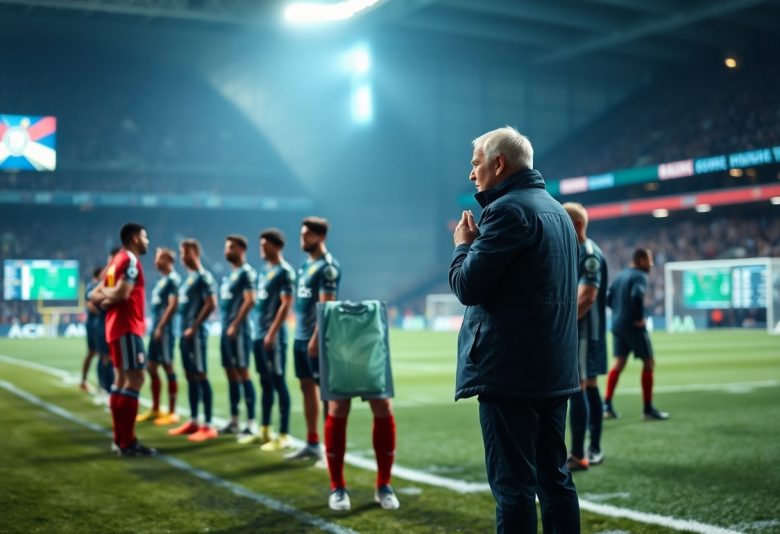Over the years, tactical flexibility in football has significantly evolved, reshaping the responsibilities and strategies surrounding substitutes. You may have noticed that today’s managers rely on their bench players not only for cover but also for tactical adjustments during matches. Understanding how these changes impact game dynamics and your team’s performance can enhance your appreciation for the sport. In this post, we will explore the transformation of substitutes in modern football and how you can adapt your viewing lens to better understand these pivotal roles.
Evolution of Tactical Flexibility in Football
Your understanding of football tactics has undoubtedly evolved as the game has shifted towards greater flexibility. This transformation has redefined not only how teams approach their gameplay but also the strategic use of substitutes, impacting how coaches deploy their bench options during crucial moments in matches.
Historical Context
Context plays a significant role in grasping how tactical flexibility has evolved throughout football’s history. In the early days, teams often relied on rigid formations and specific roles, with substitutions primarily made for injuries. As the game progressed, tactical experimentation began to reveal the advantages of adaptable strategies, allowing teams to adjust to opponents and game situations more dynamically.
Key Tactical Developments
The landscape of football tactics has been shaped by several key developments that you should be aware of. Innovations such as the total football philosophy, the introduction of versatile players, and the influence of data analysis have each played a part in promoting broader tactical flexibility. These shifts have encouraged coaches to think beyond conventional strategies, enabling them to make more impactful substitutions as they adapt to the unfolding dynamics on the pitch.
Developments in tactics have increasingly emphasized adaptability in gameplay. This flexibility includes the rise of formations that can interchange positions seamlessly, the use of players who can excel in multiple roles, and the strategic analysis of in-game performance metrics. As a result, teams can implement real-time changes that enhance their effectiveness, leading to a more fluid style of play. The resulting emphasis on tactical flexibility has empowered coaches to utilize substitutes not just for injuries, but to exploit weaknesses and enhance team performance dynamically.
The Changing Role of Substitutes
Even as football evolves, the role of substitutes has transformed dramatically. No longer merely backup players, substitutes now embody tactical flexibility, allowing coaches to reshape matches in real-time. Their involvement can significantly influence the game’s dynamics, providing teams with fresh energy and varying strategies to counter opponents effectively. This shift has rendered substitutes an vital part of your team’s overall strategy, demanding skills that go beyond mere replacement for fatigued players.
Strategic Use of Substitutions
Around the modern game, the strategic use of substitutions has become vital to overall success. Coaches now analyze match situations closely, timing their changes to maximize impact. This allows you to adapt formations, inject fresh players into the mix, and exploit weaknesses in the opposition. By utilizing these tactical switches, you can maintain a competitive edge, balancing offense and defense as needed throughout the match.
Impact on Team Dynamics
Impact on team dynamics is profound, as the integration of substitutes influences not only gameplay but also player motivation and morale. You find that fresh legs can revitalize a tiring team, fostering an environment for resurgence and adaptability. The interplay between starting players and substitutes establishes cohesion, as each individual understands their role and contributes to a common goal, enhancing team spirit.
Role players have become integral to a squad’s harmony and performance, as they must seamlessly blend into ongoing matches. Your substitutes often serve as morale boosters with their enthusiasm and energy, which can lift the spirits of both teammates and fans alike. The need for strong communication and understanding between starting and bench players emphasizes teamwork, making you aware that every member holds significance in achieving success. With tactical flexibility at the forefront, the synergy between starters and substitutes shapes the overall identity and strategy of your team.
The Influence of Technology and Data Analysis
Assuming you are aware of the increasing importance of technology in football, it’s evident that data analysis has significantly reshaped how substitutes are deployed. Coaches now rely on sophisticated software and analytics to evaluate player performance, fitness levels, and match dynamics, allowing for more informed decision-making during games.
Performance Metrics and Substitution Decisions
Against traditional methods, today’s coaches utilize real-time performance metrics to guide substitution decisions. These analytics enable you to assess factors such as player fatigue, tactical alignment, and potential match impacts, ensuring that your team’s effectiveness is maximized and strategic needs are met seamlessly.
Tactical Adaptations Informed by Analytics
To fully leverage the insights afforded by analytics, you must recognize how data influences tactical adaptations. With detailed analysis of opponents’ weaknesses and your team’s strengths at hand, you can identify the ideal moments to introduce substitutes who not only fit the tactical plan but can also exploit specific match situations.
Metrics from data analysis include player movement patterns, heat maps, and success rates in various scenarios. By evaluating these metrics, you effectively position substitutes to enhance your team’s performance and address opposing threats. This targeted approach allows you to make tactical adjustments that were previously unimaginable, creating a multi-dimensional strategy that can alter match outcomes in your favor.
Case Studies of Successful Tactical Flexibility
All modern football showcases how tactical flexibility can elevate a team’s performance, particularly through strategic substitutions. Here are some notable case studies:
- 2019 UEFA Champions League: Liverpool trailing 0-3 against Barcelona came back to win 4-0 by effectively utilizing their subs.
- 2023 FIFA World Cup: France rotated their midfielders at halftime and won against England in the semifinals, emphasizing adaptability.
- 2018 Premier League: Manchester City regularly used substitutions to shift formations, helping them secure the title by a landslide.
- 2020 UEFA Euro: Italy employed real-time substitutes to transition from a defensive to an attacking strategy, ultimately winning the tournament.
Notable Teams and Their Approaches
Approaches to tactical flexibility have been as diverse as the teams that employ them. For instance, teams like Manchester City and Bayern Munich expertly rotate players based on match situation, allowing for dynamic changes in strategy. Similarly, clubs in lower leagues often adapt their formations to conserve energy and exploit opponents’ weaknesses, showcasing that tactical flexibility is not confined to elite teams alone.
Pivotal Matches Illustrating Substitution Strategy
Across numerous matches, the impact of strategic substitutions highlights the importance of tactical flexibility. Coaches often harness substitutes to alter the flow of a game, whether by introducing fresh legs to maintain intensity or shifting tactics to exploit weaknesses in the opponent’s formation.
Indeed, analyzing specific pivotal matches, you can see how effective substitutions led to unexpected victories. A notable example is Tottenham Hotspur’s 2019 Champions League semifinal comeback against Ajax, where a halftime substitution perfectly shifted momentum, turning a deficit into a stunning win. Such instances illustrate how your understanding of substitution strategies can influence the outcome of any match, showing that tactical flexibility is vital in seizing every opportunity on the pitch.
The Psychological Aspect of Substitutions
Once again, the role of substitutes in football extends beyond mere tactical changes; it encompasses a significant psychological dimension. Substitutions can affect team morale and individual confidence. Understanding how to manage player emotions and mindsets during these transitions allows you to foster a more cohesive and motivated squad, ultimately impacting the performance on the pitch.
Motivating and Managing Players
Motivating your players during substitutions is vital to maintaining their engagement and morale. When you make a change, it’s imperative to communicate clearly and positively with those coming off and those being brought on. Encouraging a supportive atmosphere ensures that players remain focused, knowing their contributions are valued, which is key to maintaining team spirit.
Building Team Cohesion
Before you can build effective team cohesion, you need to implement strategic substitutions that foster unity. When players feel interconnected and valued, they work better together, on and off the field. Substitutions should be seen as opportunities to integrate all players into the game’s flow, reinforcing the understanding that each member contributes to the team’s identity and success.
But establishing that level of cohesion requires intentional efforts from you as a coach. It involves ensuring that substitutes know their roles and how they fit into the bigger picture. Effective pre-game communication and post-match debriefs can help create a culture where each player feels integral to the team’s mission. By making strategic substitutions that align with team goals, you enhance the bond among players and promote a collective mentality, ultimately leading to improved performance throughout the entire game.
Future Trends in Tactical Substitutions
Keep an eye on how tactical substitutions will continue to evolve in the coming years, as teams leverage innovative strategies to maximize player impact. As technology and data analytics improve, expect coaches to adopt increasingly flexible approaches. The introduction of additional substitutions in various leagues could further encourage tactical creativity, giving managers more opportunities to exploit match situations dynamically.
Anticipated Developments in Football Strategy
For the future, you can anticipate a shift towards even more specialized roles for substitutes, especially in high-stakes matches where tactical nuance becomes vital. Teams may begin to utilize substitutes not just for fatigue management but also to counteract specific opposition strategies, allowing for a more fluid and adaptable style of play.
Role of Coaches and Analysts
Beside developing tactical approaches, your coaches and analysts will play an vital role in predicting match dynamics and making informed substitution decisions. The integration of match data and real-time analysis will empower substitutes to impact matches more effectively than ever before.
Tactical insights generated from data analysis will help you and your coaching staff tailor substitutions to exploit opponent weaknesses or reinforce your team’s strengths during crucial match phases. By closely monitoring player performance metrics, you can make timely decisions that shift the momentum of a match, ensuring your substitutions are not merely reactive but strategic, contributing meaningfully to your overall game plan.
To wrap up
Hence, you can see that tactical flexibility in football has significantly transformed the role of substitutes, allowing for more strategic game management and enhancing team performance. As you adapt to this evolution, you’ll realize that your ability to make informed substitutions can greatly influence match outcomes. By understanding the dynamic nature of modern football, you can leverage your substitutes to not only maintain but also shift the momentum of the game, ultimately shaping your team’s success on the pitch.




